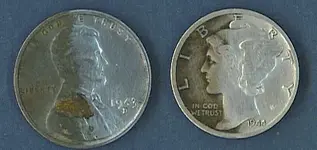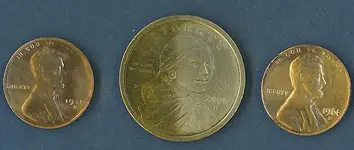Will take your word for it that the scratches were already there, but to me, they look like brush marks. I would avoid anything that would even remotely have the chance of scratching the surface. Sand Paper, Steel Wool, Scotch Brite pads, brushes and so on. Look real closely and you see how all the scratches run the same direction etc.
Like I said, that is just what I am seeing in the pictures. I don't know what the coins looked like originally.
Similarly, I think there is a term for it, where people hold coins to a spinning pad or brush or something. Whirring

I could have the term wrong. It involves similar cleaning and very fine scratches. Some such that you don't see them as scratches as they are so fine. If I recall, it is noticable in the halo effect that some coins have resulting from the circular buffing.
Anyway, I would first try some of the dip methods that you can find. Salt and Vinegar or Lemon Juice. (salt and acid). There are others also. Read back in this topic. I have seen dozens of posts on this subject in the last couple weeks. I found that Barkeepers Friend worked real good on some pennies. Cleaned them nice and bright but didn't do much for the crust that was on some of the coins. If that doesn't work and If it is encrusted heavilly you might try a medium tooth brush or use a rock tumbler with some nut shells or other fairly soft, fine medium in it. There are many different things that people use. Add a little tide and some water. Not a lot, I would guess. I had the thought of some patches cut from some old blue jeans. A thought that comes from how coins look when they have come out of my jeans in the laundry. Or, you might clean the coins in a dry tumbler with some dry rice

I wonder if that would work. Might not be hard enough to mar the surface of the coin but would help in removing grit and crust. The combination between the cleaning medium and the other coins in the tumbler knocking around should take off the crust. Also, an ultrasonic cleaner is an option too. That might even be better as nothing is knocking against the coins and there is no abrasion or contact. The way it works is that the liquid in the cleaner vibrates at such a high frequency, and in some cases is heated also, to a point where it loosesns all the grime attached to an item. Some people have even had success using Ultrasonic to clean coins without damaging the desirable darkening or patina of the coins. Note that some cleaners will remove the patina and others won't. With the tumbler, don't go too long. I am sure someone here can tell you more what to use and how long to tumble. Last night I saw a post from someone who forgot to turn the tumbler off. After 24 hours, the back side, (wheat side) of a penny was polished smooth with no markings left. TOO LONG. I want to say that 10 or 15 minutes is common

If the coin is something that I might want to clean up and keep, that isn't particularly special, I might think of the Simichrome. I used to use in High School when I went to a Military Academy. We used it on all our brass and bronze items. Buttons belt buckles, Monograms and insignias... I have had trouble finding it locally though. Last I saw it was at an auto parts store. I understand it is popular with motor cycle owners. You might check where they would buy their supplies. Or, there are many places online. You can even get it, I think, through Amazon.com. Lately though, I have used MAAS. From my experience with Simichrome, using it intensely for over 6 years, 7th through 12th grade and beyond, MAAS seems to be the same thing. Same color, same smell works the same.... I think it the same product imported from Germany and sold under another name. My understanding is that MAAS and probably Simichrome contain a polishing compound called Rouge. That is a stone that is extremely fine and is used to polish jewelry and other metal objects. Look for a jewelry making supplier. Something else that could be good to have on hand are Rouge Clothes. They are polishing clothes. One side is yellow, if I recall and the other is Dark Red (Rouge) and contains some of the rouge compound. All you have to do is wipe your object with it and it should come to a high polish. Buff clean with the yellow side of the cloth. No paste little mess. I think MAAS and probably Simichrome too, also contain something that might protect the surface also. Maybe a wax or polymer or something. Whenever I am finished cleaning something with MAAS, I wash it under warm water to clean off any residue. I notice that the surface beads like your car after you wash it.
If the coin is something that is bad and can't be spent in it's condition, I am thinking the ultrasonic or tumbler, just to put it back into circulation. Otherwise, why go through the trouble to try and polish it.
If it is bad and you can't determine it's value or identity, try a dip or the ultrasonic first, Then go to the tumbler if you have to. After you can decern the value of the coin, decide if you want to just put it back into circulation, clean it or polish it for your personal interests or collection or keep it au naturale for it's age and collector value.







 I could have the term wrong. It involves similar cleaning and very fine scratches. Some such that you don't see them as scratches as they are so fine. If I recall, it is noticable in the halo effect that some coins have resulting from the circular buffing.
I could have the term wrong. It involves similar cleaning and very fine scratches. Some such that you don't see them as scratches as they are so fine. If I recall, it is noticable in the halo effect that some coins have resulting from the circular buffing. 
